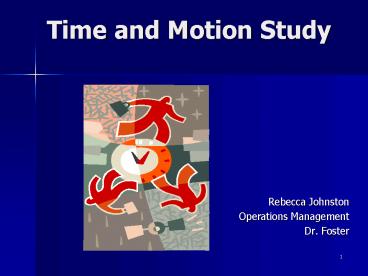Time and Motion Study - PowerPoint PPT Presentation
1 / 18
Title:
Time and Motion Study
Description:
Time and Motion Study Rebecca Johnston Operations Management Dr. Foster Time and Motion Study: Defined A method created to determine the correct time it takes ... – PowerPoint PPT presentation
Number of Views:2027
Avg rating:3.0/5.0
Title: Time and Motion Study
1
Time and Motion Study
- Rebecca Johnston
- Operations Management
- Dr. Foster
2
Time and Motion Study Defined
- A method created to determine the correct time
it takes to complete a certain task - A method to establish the one best way to
perform a task
3
Time and Motion Study Purposes
- To end goofing off and to establish what
constituted a fair days work - To make sure that the job being evaluated does
not include any unnecessary motion by the worker
4
Time and Motion Study History
- Frederick W. Taylor and his followers developed
and refined the Time Study - Frank B. Gilbreth and his wife Lillian developed
and refined the Motion Study - Historically the two studies are discussed
individually, today they generally are discussed
as one
5
Time and Motion Study In your Organization
- Historically TM Studies were used in the
manufacturing industry to evolve pay scales with
the thought that money was the only motivation
for work
6
Time and Motion Study In your Organization contd
- Today
- TM Studies can be effective for performance
evaluations - TM Studies can be used for planning purposes in
order to predict the level of output that may be
achieved - TM Studies can be used to uncover problems and
create solutions - TM Studies can be used for time cost analysis
7
Time and Motion Study Objective
- The objective of the Time and Motion Study is
to determine a normal or average time for a
job, by using observers to record exactly how
much time is being devoted to each task.
8
How it Works Step-by-Step
- 1. Establish the standard job method.
- 2. Break down the
- job into elements
- 3. Study the job.
- 4. Rate the workers performance
9
How it Works Step-by-Step contd
- 5. Compute the average time
- 6. Compute the normal time
- Nt(t)(RF) or
- Normal Time(elemental average time)
- (rating factor)
- 7. Compute the standard time
- ST(Nt)(1AF) or
- Standard Time(Normal cycle time)(1Allowance
factor)
10
Time and Motion Study In Action
- How do medical residents spend their time at the
hospital?
11
In Action contd
- 1. Coders/observers training was the
- 2. Activities were broken down into separate
categories, 67 in total - 3. The exact number of minutes per task were
determined - 4. Percentages of time devoted to each task were
calculated
12
In Action contd
- A total of 13,383 minutes of activities were
observed between the 8 residents - Residents were involved in 1,726 coded activities
- These activities averaged 7.75 minutes each with
a standard deviation of 14.5 minutes
13
Time and Motion Study Exercise
Element t (min) RF
1 2.51 1.10
2 5.29 1.15
3 4.21 1.10
4 3.57 1.05
- Compute the standard time for this job using an
allowance factor of 20 percent.
14
Solution
- Use the formula
- (t)(RF)Nt
- Element 1
- (.251)(1.10).2761
- Element 2
- (.529)(1.15).6084
- And so on for element 3 and 4
Element T(min) RF t Nt
1 2.51 1.10 .251 .2761
2 5.29 1.15 .529 .6084
3 4.21 1.10 .421 .4631
4 3.57 1.05 .357 .3749
To get the normal cycle time you sum the Nt
values. Here 1.73 min
15
Solution
- To compute the standard time use the 20 percent
allowance factor - Nt(1AF)ST
- Here
- 1.73(1.20)2.08
- So the standard time for each element of this job
is 2.08 minutes
16
Time and Motion Study Problems
- Observers are not always competent
- Those conducting the study are not always
proficient in the job being observed - The actions observed are not always reflective of
the group as a whole
17
Time and Motion Study Problems contd
- Workers may not cooperate with a time and motion
study - They may resent the study if it is being used to
determine the pay scale - Workers may change the rate at which they work
- Pressure may increase mistakes made
- Workers may alter normal work methods to disrupt
the study
18
References
- Ferguson, David S., Dont Call it time and
motion study, IIT Solutions, Norcross. May 1997.
Vol. 29, Issue 5. - Finkler, Steven A., A Comparison of work-sampling
and time-and-motion techniques for studies in
health services research, Health Service
Research, Chicago. Dec 1993. Vol. 28, Issue 5. - Koehler, Kenneth G., Time Cost Analysis, CMA,
Hamilton. May 1992. Vol. 66, Issue 4. - Russell, Roberta Taylor, Bernard W., Operations
Management, Prentice Hall Inc., Upper Saddle
River, NJ. 2000. - Stevens, Larry, Time Study Prompts New HR
Efficiencies, Personnel Journal, Santa Monica.
April 1994. Vol. 73, Issue 4. - Stuttaford, Genevieve, The One Best Way Fredrick
Winslow Taylor the Enigma of Efficiency,
Publishers Weekly, New York. March 17, 1997. Vol.
224, Issue 11.

